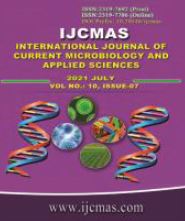


 National Academy of Agricultural Sciences (NAAS)
National Academy of Agricultural Sciences (NAAS)

|
PRINT ISSN : 2319-7692
Online ISSN : 2319-7706 Issues : 12 per year Publisher : Excellent Publishers Email : editorijcmas@gmail.com / submit@ijcmas.com Editor-in-chief: Dr.M.Prakash Index Copernicus ICV 2018: 95.39 NAAS RATING 2020: 5.38 |
Cashew (Anacardium occidentale L.), a tree native of Eastern Brazil, was introduced in India by the Portuguese nearly five centuries ago. In India, cashew is grown in the peninsular areas of Kerala, Karnataka, Goa and Maharashtra, Tamil Nadu, Andhra Pradesh, Orissa and West Bengal. The country is the single largest producer and exporter of cashews, accounting for 40% of the global share. In Tamil Nadu Pudukkottai, Cuddalore, Perambalure, Sivagangai districts are contributing majore share cultivating Cashew. In Pudukkottai Thiruvarankulam, Gardarvakkottai and Arimalam are the three main blocks cultivating Cashew. Totally 6365ha are cultivating Cashew in this district with the production value of 5665 MT. The 2016 season started at 115 to 117 per kg as against the starting price of 102 to 105 per kg last season. KVK, Vamban, Pudukkottai conducted Front Line Demonstration on foliar nutrition in cashew study was carried out in Pudukkottai district with the following objective. To study the socio-economic profile of the sample farmer s viz., To analyze the labour and input utilization pattern in Cashew cultivation, To analyze the profitability in Cashew cultivation, To document various constraints faced by the Cashew growers in the study area. Technological foliar recommendation viz., New flush stage Foliar application of 1% 19:19:19, Flowering stage: Foliar application of MAP 1% + borax 0.1%, Fruit set stage Foliar application of Panchagavya 3%. It has been observed that technological interventions like foliar spray, swabbing with recommended chemicals and plant protection measures (Ohler, 1979) increased nut yield by 20- 25per cent at farmer’s field and with the application of irrigation and foliar spray during December, January and February, the yield increased by 20 percent (Gibbon, 2001), Integrated Crop Management cultivation was found to be economical with a B:C ratio of 3.0. Efforts should be made in the selection and production of improved released verities, identification of appropriate quantity and time of irrigation, training on application of organic input should be provided. From the study it was revealed that price of dried nuts with minimal processing fetches more price than raw nuts. Therefore, the farmers need to be encouraged to take up processing by themselves by giving them subsidy and/or loan for establishing the small scale processing units.
 |
 |
 |
 |
 |